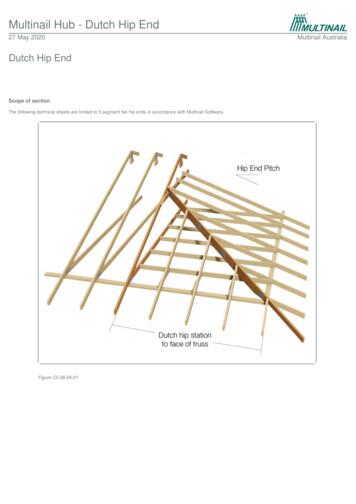Hygiene Improvement Project (HIP)
Hygiene ImprovementProject (HIP)DC DebriefMarch 2, 2006Merri WeingerFeb 5-11Julia RosenbaumFeb 5-18
Hygiene ImprovementProject (HIP)Objectives of TDY¾¾¾¾¾¾¾Finalize WSP-USAID/HIP-Amhara RHB proposal andaction planAdvance recruitment process for regional advisorConduct interviews with top candidatesTravel to Amhara to informally launch at scale HI andmeet with partnersAgree on final proposal and initial action stepsFinalize office arrangements for regional coordinatorDiscuss and concretize USAID involvement
Program to SupportAt ScaleImplementationof the NationalHygiene &Sanitation Strategythrough“Learning by Doing”in the Amhara Region
Program Purpose¾¾To support implementation of the NationalHygiene & Sanitation Strategy through “learningby doing” in one region, Amhara, and, in theprocess, help the Regional Health Bureauachieve its targets relating to hygiene andsanitation.The experiences, guidelines, tools and materialsdeveloped through the Amhara experience willbe refined, documented and adapted forimmediate application in other regions.
Program complements parallel efforts¾ Development ofthe nationalsanitation protocol¾ Water supply andinvestmentprograms
Program Outputs¾ RHB strengthened to develop & delivereffective HI¾ Varied partnerships are established toensure comprehensive programming¾ Linkages are extended, new partners join¾ Communication strategies and messagesare harmonized
Before:Stakeholder rld LearningWB-WSPESHEBoWRHealthCtrsRBHealthKebele CmtWorldCAREVisionHEWsKebeleLeadersSchools
Stakeholder Relationships – AfterBOEBoWRBoHRegionalAdvisorWorld LearningWASHCOs6 aders
Specific outputs include ¾¾¾¾¾¾¾¾Implementation Guidelines, including tools and materialsRegional Action Plan for coordinated hygieneimprovementRegional Capacity-building Strategy and related modulesCommunication Strategy related support materialsRegional and woreda-level advocacy strategyEstablishment of regional resource centre(s) /communities of practiceM&E framework and system for program, includingindicatorsGuidelines for baseline survey and/or enhancedmonitoring data collection
Approach¾¾¾¾¾¾¾¾Participatory ApproachesCoordinated implementationEnhanced partnershipsHarmonized messagesCapacity strengtheningRegional Bureaus andWoredas use their implementationfunds for activities and materialsDonors accept the overall approach so thatthese activities become “eligible or fundable”
The Regional Advisor provides TA to assure ¾¾¾¾¾Good practice in hygiene behaviour changeHarmonized messagesCoordination of key actorsStrengthened regional capacityFocused TA available from additional regionaland international advisors
Timeline and Phases¾16 month “initial” program¾5 PhaseszzzzzAssess and PlanCatalyze/Build Partnerships/StrategizeImplement ActivitiesMonitor ProgressSynthesize & document process
Program Inputs¾¾¾¾¾¾¾¾¾16 months of national AdvisorFive months of international, focused TAProject & partnership management, stakeholdercoordination, quality assurance (thru TA from WSP-AFregional management specialists, USAID/HIP)Materials development & documentation of lessonsLimited development of support materials and curriculumLimited coverage of some operational costs of the RHBoffice in Bahir DarTravel costs and field allowances for Regional Advisorand consultantsWorkshops, seminars & learning events across all tasksLearning exchanges between regions
Linkages with USAID Projects¾Met within USAID & with implementation partnerszzCS Task Force (Dr. Kassahun)WatSan focal person (Dr. Mulugeta) Enhanced role and increased visibility of USAID in nationalmovement for HI – WASH committee and launch; NationalHygiene and Sanitation Strategy; CARE/MWAzChild Health/ Communications (Ato Eshete) ESHE National and Amhara Region HCP – Kokeb Kebele, soap opera?
¾Basic Ed: Aberra MakonnenzzBESO(World Learning)- PTA¾PSIFHI- Addis and Amhara¾Non USAID Partners¾zz¾UNICEFWaterAidOFDA –zrequested concept note on building capacity of NGO partners tointegrate HI into water relief in drought stricken Somali Region
Next steps¾Recruitment and installation of RA Recruitment Suggestions?¾Mapping of existing resources in AmharaEstablishment of regional coordinating body?Baseline?Regional plans and budgets prepared by lateApril, need to assure that these activitiestranslate to the performance indicatorsWork towards stakeholders meeting in June¾[OFDA Concept Note]¾¾¾¾
Please don’t hesitate to contact us Merri Weingermweinger@usaid.govJulia Rosenbaumjrosenba@aed.org
Objectives of TDY ¾Finalize WSP-USAID/HIP-Amhara RHB proposal and action plan ¾Advance recruitment process for regional advisor ¾Conduct interviews with top candidates ¾Travel to Amhara to informally launch at scale HI and meet with partners ¾Agree on final proposal and initial action steps ¾Finalize office arrangements for regional coordinator ¾Discuss and concretize USAID involvement
FOOD HYGIENE (BASIC TEXTS) Fourth edition The Codex basic texts on food hygiene promote understanding of how rules and regulations on food hygiene are developed and applied. The General Principles of food hygiene cover hygiene practices from primary production through to final consumption, highlighting the key hygiene controls at each stage.
A hand hygiene action is defined as hand-rubbing with an alcohol-based product or by hand washing with soap and water i 4.7 Hand hygiene indication The WHO 'Five Moments for Hand Hygiene' are used to define a hand hygiene indication or indications i 4.8 Hand hygiene opportunity A hand hygiene opportunity is defined as the requirement
hip for this explanation of total hip replacement. There can be other reasons for the re-placement, but, in general, the hip replacement method will be similar. To understand a total hip replacement, you must first understand the structure of the hip joint. The hip joint is a ball-and-socket
Hip Fracture: Patient Education Handbook AdventHealth - Orthopedic Institute Orlando Understanding the Hip & Hip Fractures Anatomy and Function The hip is a ball and socket joint. The pelvic bone contains the cup shaped “socket” (acetabulum) that holds the “ball” (femoral head). Together they form your hip, and allow
each hip action and the primary muscle group it targets. Figure 8 is based on three hip movements: hip sway, hip tuck, and hip roll are the foundation for the Figure 8 training. With the hip roll, you rotate your hips a complete 360 degrees. This fires and stretches the back, sides, a
brace to limit hip flexion. Hip flexion limit to 45 degrees Quad sets, active-assisted and passive hip and knee flexion, ankle pumps Hip flexion ROM limit 60 flexion None None Weight bearing TDWB crutches Post-op hip brace Limit hip flexion to 45 Phase Two 2 to 6 weeks after surgery PWB 50%
The “Hip Rafters” are positioned from the corner of the span / area and to the centre of the Dutch Hip Girder. Jack Top Chord to Hip Top Chord: Use ‘effective’ flat-head 3/75mm x 3.05Ø nails. Hip Top Chord to be mitre cut. Jack and Hip Top Chord to Waling Plate: Use 30 x 0.8mm looped
What causes a hip fracture? Falls are the most common cause of a hip fracture. As we get older, our strength and balance can reduce and our bones become thinner due to conditions like osteoporosis. What is a hip fracture? The hip is a ball and socket joint where the pelvis and thigh bone (femur) meet. A hip fracture is























